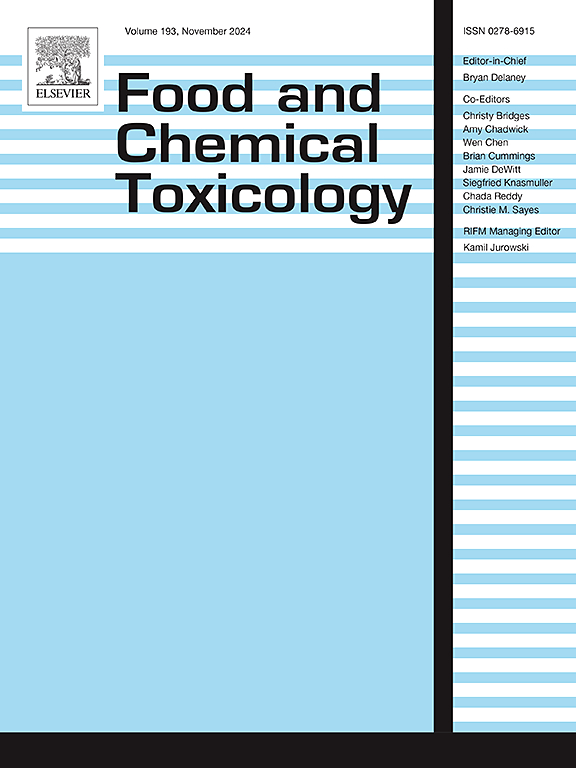Environmental exposure to titanium dioxide nanoparticles disrupts DAZL gene expression and male reproductive function in mice: Protective role of lutein
IF 3.9
3区 医学
Q2 FOOD SCIENCE & TECHNOLOGY
引用次数: 0
Abstract
Titanium dioxide nanoparticles (TiO2 NPs) are widely used nanomaterials with potential environmental health concerns, including impacts on male fertility. This study investigated the effects of TiO2 NPs on male reproductive function in mice and the potential protective role of lutein, a dietary antioxidant. Male NMRI mice were exposed to TiO2 NPs (50, 150, and 300 mg/kg) with or without co-administration of lutein (5 or 10 mg/kg) for 35 days. Compared to controls, TiO2 NP exposure significantly decreased DAZL gene expression, testosterone levels, antioxidant capacity, sperm quality (motility, density, morphology, DNA integrity), and testicular tissue parameters (seminiferous tubules volume, germinal epithelium height, spermatogenic cell counts). These effects were associated with increased oxidative stress markers (malondialdehyde levels) and altered testicular architecture (interstitial tissue volume). Notably, co-administration of lutein significantly ameliorated these TiO2 NP-induced adverse effects, suggesting its potential protective role against testicular oxidative stress and dysfunction. Our findings highlight the potential detrimental effects of environmental TiO2 NP exposure on male fertility and the potential benefit of dietary lutein as a protective strategy. Further research is needed to explore the underlying mechanisms and translate these findings to human health.
暴露于二氧化钛纳米颗粒的环境会干扰小鼠 DAZL 基因表达和雄性生殖功能:叶黄素的保护作用
二氧化钛纳米粒子(TiO2 NPs)是一种广泛使用的纳米材料,具有潜在的环境健康问题,包括对男性生育能力的影响。本研究调查了二氧化钛纳米粒子对雄性小鼠生殖功能的影响以及叶黄素(一种膳食抗氧化剂)的潜在保护作用。雄性NMRI小鼠接触二氧化钛氮氧化物(50、150和300毫克/千克)35天,同时或不同时服用叶黄素(5或10毫克/千克)。与对照组相比,暴露于二氧化钛氮氧化物会显著降低DAZL基因表达、睾酮水平、抗氧化能力、精子质量(活力、密度、形态、DNA完整性)和睾丸组织参数(曲细精管体积、生精上皮高度、生精细胞计数)。这些影响与氧化应激标记物(丙二醛水平)的增加和睾丸结构(间质组织体积)的改变有关。值得注意的是,同时服用叶黄素能明显改善二氧化钛氮氧化物诱导的这些不良影响,这表明叶黄素对睾丸氧化应激和功能障碍具有潜在的保护作用。我们的研究结果突显了暴露于环境中的二氧化钛氮氧化物对男性生育能力的潜在不利影响,以及膳食叶黄素作为一种保护策略的潜在益处。还需要进一步的研究来探索其潜在机制,并将这些发现应用于人类健康。
本文章由计算机程序翻译,如有差异,请以英文原文为准。
求助全文
约1分钟内获得全文
求助全文
来源期刊

Food and Chemical Toxicology
工程技术-毒理学
CiteScore
10.90
自引率
4.70%
发文量
651
审稿时长
31 days
期刊介绍:
Food and Chemical Toxicology (FCT), an internationally renowned journal, that publishes original research articles and reviews on toxic effects, in animals and humans, of natural or synthetic chemicals occurring in the human environment with particular emphasis on food, drugs, and chemicals, including agricultural and industrial safety, and consumer product safety. Areas such as safety evaluation of novel foods and ingredients, biotechnologically-derived products, and nanomaterials are included in the scope of the journal. FCT also encourages submission of papers on inter-relationships between nutrition and toxicology and on in vitro techniques, particularly those fostering the 3 Rs.
The principal aim of the journal is to publish high impact, scholarly work and to serve as a multidisciplinary forum for research in toxicology. Papers submitted will be judged on the basis of scientific originality and contribution to the field, quality and subject matter. Studies should address at least one of the following:
-Adverse physiological/biochemical, or pathological changes induced by specific defined substances
-New techniques for assessing potential toxicity, including molecular biology
-Mechanisms underlying toxic phenomena
-Toxicological examinations of specific chemicals or consumer products, both those showing adverse effects and those demonstrating safety, that meet current standards of scientific acceptability.
Authors must clearly and briefly identify what novel toxic effect (s) or toxic mechanism (s) of the chemical are being reported and what their significance is in the abstract. Furthermore, sufficient doses should be included in order to provide information on NOAEL/LOAEL values.
 求助内容:
求助内容: 应助结果提醒方式:
应助结果提醒方式:


